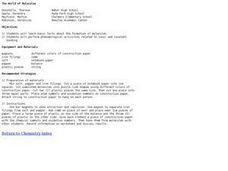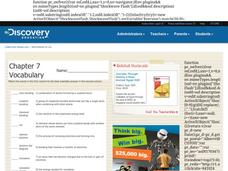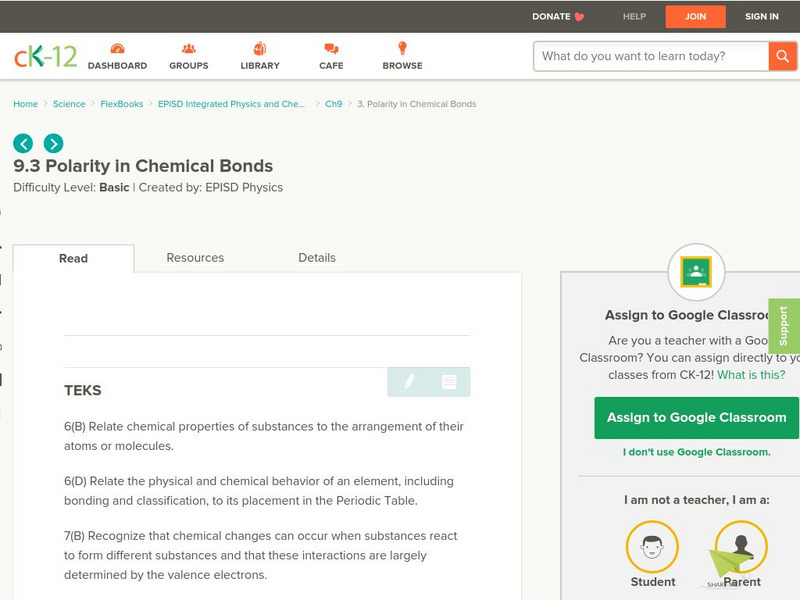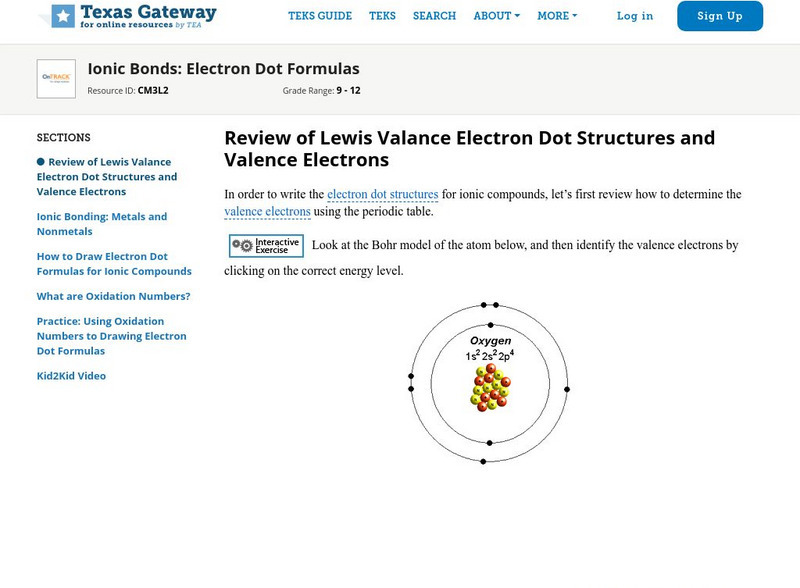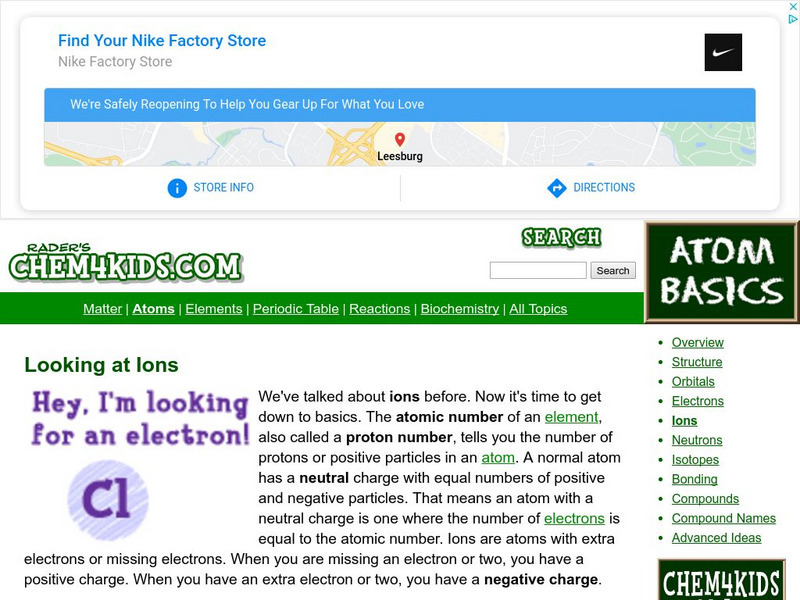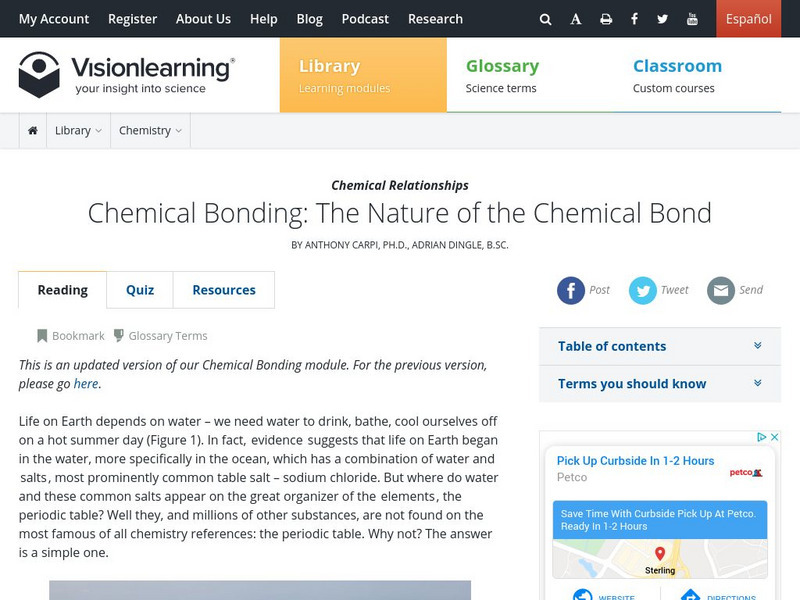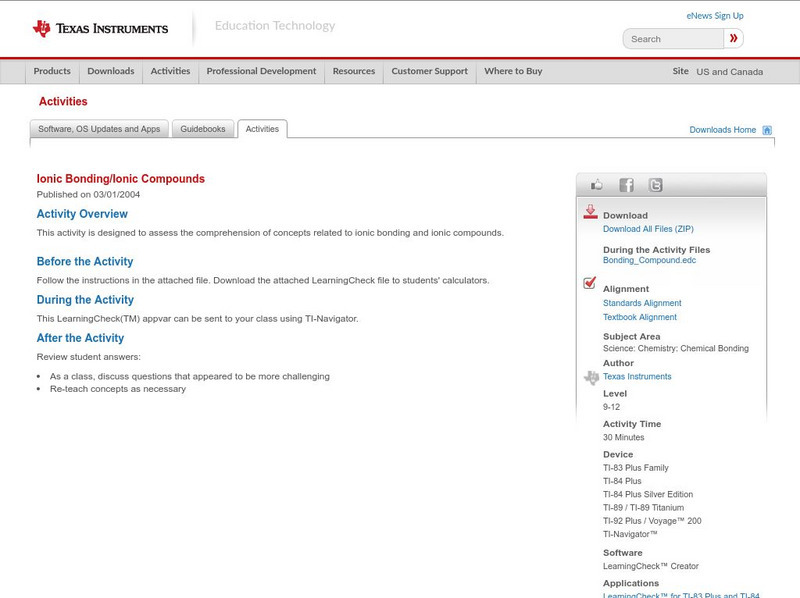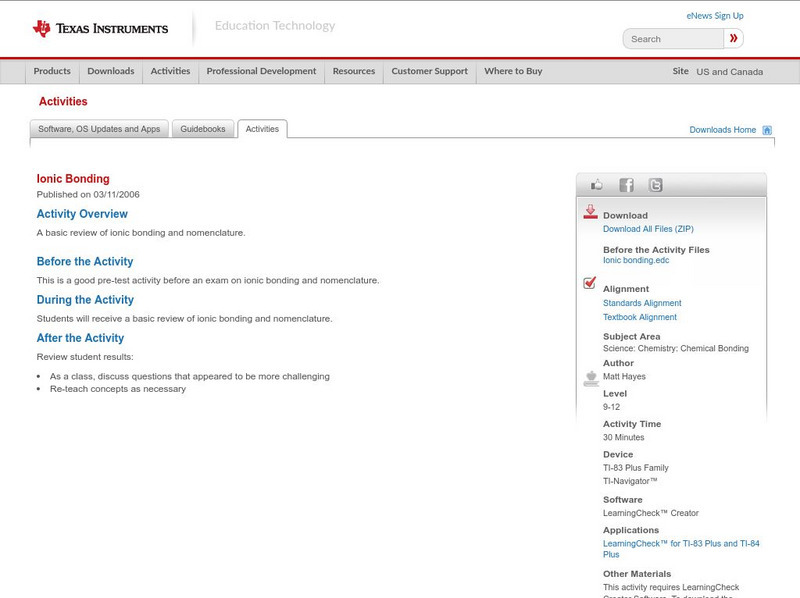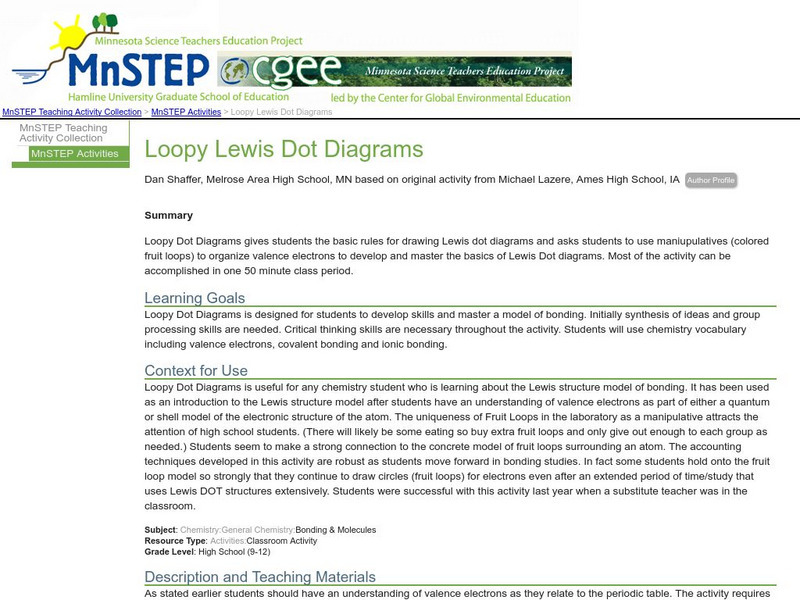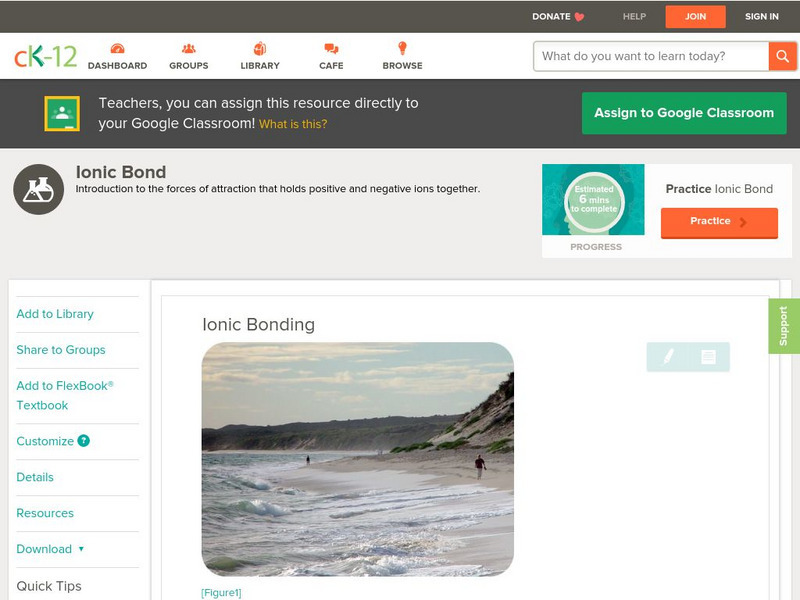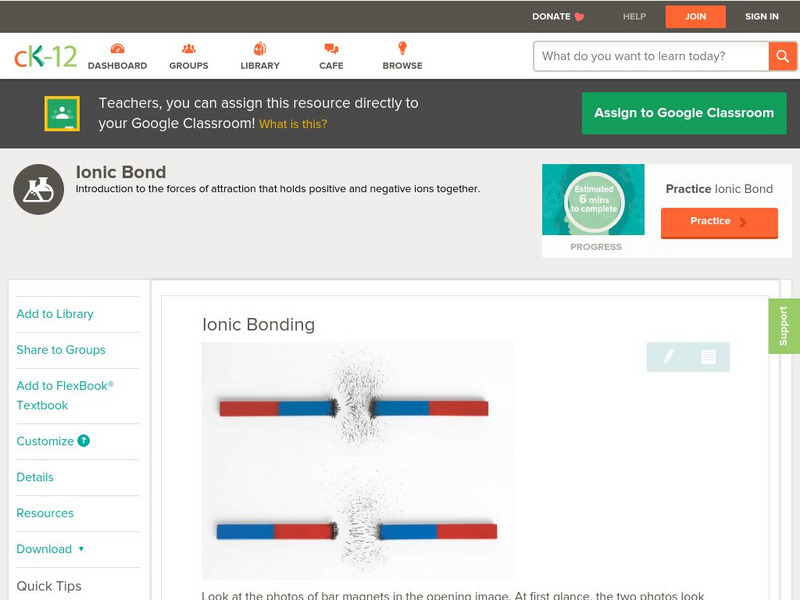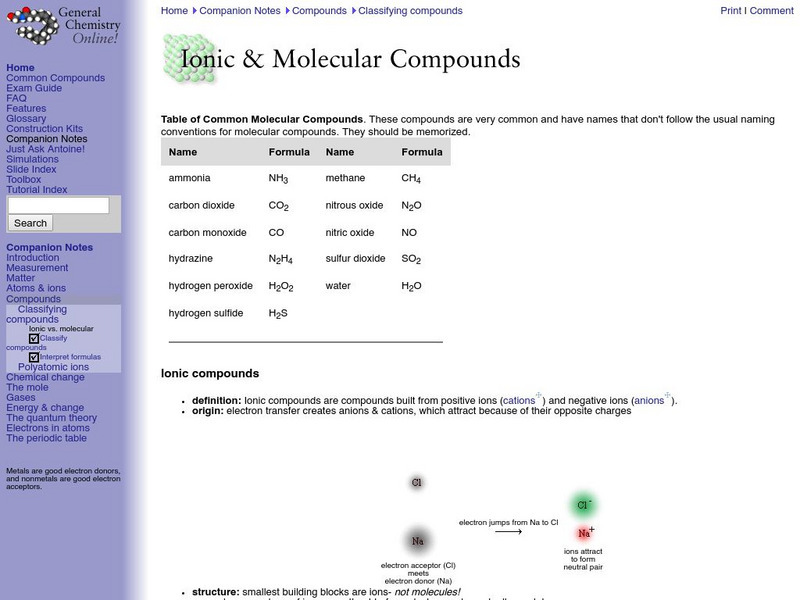Curated OER
Bonding
Almost a complete lesson in itself, this presentation will enhance any bonding and compounds unit. The concepts included are charges of atoms lending to particular molecular structures, the stability of bonds and how to diagram them....
Curated OER
Ionic Bonding
This clear overview of ions and ion formation will be useful for either review or note taking. Each slide has quite a lot of text on it, but they are bullet pointed well, and you could edit the slideshow to have facts appear separately....
Curated OER
How Do Atoms Stick Together?
In this chemical bonding worksheet, students answer 10 questions about ionic bonding, covalent bonding, metallic bonding, Lewis structures, and intermolecular forces.
Curated OER
The World of Molecules
Students investigate molecules through 2 demonstrations and writing formulas for molecules given the oxidation states of the atoms. In this molecules lesson plan, students observe iron filings being separated from salt and pepper using a...
Curated OER
Intermolecular Forces Worksheet
In this intermolecular forces instructional activity, students answer 4 questions about the forces between atoms within molecules and compounds. Students rank the boiling points of compounds based on their intermolecular forces and they...
Curated OER
Chapter 7 Vocabulary
In this online vocabulary worksheet, students match 14 definitions to the correct vocabulary term. Students may click the solution button to check answers.
Curated OER
Ionic Bonding
For this ionic bonding worksheet, students observe diagrams about ionic bonds and crystal formation. They answer 37 short answer questions about the properties of monatomic ions, polytomic ions and write correct formulas.
CK-12 Foundation
Ck 12: Polarity in Chemical Bonds
[Free Registration/Login may be required to access all resource tools.] Students will determine the polarity of a chemical bond using the electronegativity chart, and then distinguish between nonpolar covalent, polar covalent, and ionic...
Texas Education Agency
Texas Gateway: Ionic Bonds: Electron Dot Formulas
Given descriptions, diagrams, scenarios, or chemical symbols, students will model ionic bonds using electron dot formulas.
Chem4kids
Chem4 Kids: Ions
Here at Chem4Kids you can learn all about ions. Content explores what an ion is, its various characteristics, electrovalence, and more.
Vision Learning
Visionlearning: Chemistry: The Nature of the Chemical Bond
This site talks about ionic, polar covalent, and non-polar covalent bonding.
American Chemical Society
Middle School Chemistry: Chapter 4: The Periodic Table and Bonding
Six middle school chemistry lessons about the periodic table and bonding complete with handouts and animations.
Cosmo Learning
Cosmo Learning: Introduction to Solid State Chemistry
A collection of video lectures from a course that investigates the application of basic chemistry principals to engineering systems. The course draws from industrial practice to give examples of the application in engineering systems. In...
PBS
Pbs Learning Media: Ionic Bonding
A tutorial illustrating ionic bonding. Tutorial explains how and why it occurs with animations and some interactive activities throughout. Explore the bond that forms between sodium and chlorine as you count the number of atoms present.
Texas Instruments
Texas Instruments: Ionic Bonding/ionic Compounds
This activity is designed to assess the comprehension of concepts related to ionic bonding and ionic compounds.
Texas Instruments
Texas Instruments: Ionic Bonding
A basic review of ionic bonding and nomenclature.
Science Education Resource Center at Carleton College
Serc: Loopy Lewis Dot Diagrams
Students will use colored fruit loops to organize valence electrons to develop and master the basics of Lewis Dot diagrams. They will develop processing and critical thinking skills and also master a model of bonding.
Ohio State University
Ohio State University: Electronegativity & Bond Polarity
Excellent graphics help this page explain the relationship between electronegativity and bond polarity.
Michael Blaber, PhD
Florida State University: Basic Concepts of Chemical Bonding: Ionic Bonding
This tutorial explains the basic concepts of ionic bonding, with a good discussion of lattice energy.
Clackamas Community College
Clackamas Community College: Ionic Compounds
This site on ionic compounds looks at why they form networks and why they are compounds. There is also a section on determining formulas for ionic compounds with several examples provided.
CK-12 Foundation
Ck 12: Chemistry: Ionic Bonding
[Free Registration/Login may be required to access all resource tools.] Covers how ions interact with one another in ionic bonds.
CK-12 Foundation
Ck 12: Physical Science: Ionic Bonding
[Free Registration/Login may be required to access all resource tools.] Ionic bonds: How and why they form, and the role of energy in their formation.
Other
University of Texas at Dallas: Attractions in Compounds
Explanation of attractive forces and energy changes involved in bonding.
Frostburg State University
General Chemistry Online: Ionic and Molecular Compounds
Provides a good outline of the concepts involved in ionic and covalent bonding, with links to definition of terms. Features a list of common molecular compounds and a chart that compares ionic and molecular compounds.





